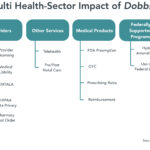August 18, 2022

Dobbs, Hyde, and Sweaty Tourists
The Supreme Court ruling in Dobbs v. Jackson Women’s Health has not just roiled the political landscape. The decision also has substantial implications across the whole ecosystem of healthcare. From mandatory State benefit packages, to prescribing rules, to Emergency Medical Treatment & Labor Act (EMTALA), Dobbs will play out in ways we’ve only begun to guess. (See Figure 1.)
Because of the near-even division of Congress, it can only posture and take test votes to “get them on the record” regarding Dobbs. In other words, fodder for the next campaign. However, at the beginning of October the first “must-pass” legislation freighted with Dobbs implications will land in Congress’ lap: appropriations bills containing the Hyde Amendment.
Hyde in Plain Sight
Prior to the Hyde amendment (1977), the Medicaid program (the joint Federal/State health insurance program for low-income individuals) could finance abortions. Adopted four years after Roe v. Wade, the Hyde amendment (named after Congressman Henry Hyde of Illinois) prohibits the use of Federal funds for abortions. However, states can use their own funds. Originally, the amendment targeted Medicaid, but anti-abortion legislators have since expanded it to include the military’s Tricare program, Federal prisons, the Peace Corps, the ACA, and the Federal Employees Health Insurance Program. The current form of the Hyde amendment allows exceptions for rape, incest, and the life of the mother.
Knowingly violating the Hyde Amendment is a crime, punishable by removing the responsible official from office or even imprisonment. [1]
Over time the two political parties have come to hold opposite views on Hyde. Hillary Clinton’s campaign called for the abolition of Hyde, while Donald Trump’s campaign called for it to become permanent law.
The Hyde Amendment is not permanent law. Instead it is a rider in some of the appropriations bills that Congress must renew annually when appropriations expire. That brings us to October 2022. The funding for government operations and the military is provided by annual appropriations. [2] Appropriations are available for a year, from October 1st to September 30th.
The Federal government’s fiscal year begins on October 1. The Congress must have appropriated funds by then, or the government “shuts down.”
By tradition, the House originates appropriations bills. Under the Congressional budget timetable, the House should complete all twelve appropriations bills by June 10. As of August 15, the House has completed action on six bills and sent them to the Senate. The Senate has taken no action. None of the House-passed bills contain the Hyde Amendment.
The Republicans will see the appropriations cycle as an opportunity to impose the Hyde amendment across the entire government. This would effectively end the Biden Administration’s stated plans to use Federal funds for out-of-state transportation or to use Federal reservations such as national parks or forests as abortion “safe havens.” Currently, the Hyde amendment does not cover the Interior (National Parks) or the Agriculture (National Forests) appropriations bills. One can expect attempts to expand Hyde into those and other appropriations bills or to change its scope to clarify that funds for out of state transportation are covered by Hyde for instance. On August 3, 2022, President Biden announced an executive order to protect abortion. We can expect that Republicans will attempt to thwart that effort by expanding Hyde. [3]
At the same time, Democrats will, at a minimum, attempt to hold the Hyde amendment at status quo or try to roll it back.

On Shutdowns
It is difficult to see a pathway to compromise by October 1. Both sides will have to test the resolve of the other, probably through a government shutdown. To paraphrase Prussian general and military theorist Carl von Clausewitz: Shutdowns are merely the continuation of budget negotiations through other means.
Prior to the Carter administration, lapses in appropriations were treated as technical matters and the business of the federal government continued as usual. In 1980 Carter’s Attorney General, Benjamin Civiletti, issued a memorandum that “business as usual” in the absence of appropriations was contrary to the law and the Constitution. The Civiletti opinion required that the processes of government stop, but it also carved out exceptions for protection of human life [4] and preservation of government property.
Article I, Section 9, Clause 7 of the Constitution states: “No Money shall be drawn from the Treasury, but in Consequence of Appropriations made by Law.” The purists of the study of the Federal budget maintain that operation of any government function in the absence of appropriations is unconstitutional. Under the purists’ interpretation, shutdowns would be nonexistent because it would mean that air traffic controllers would abandon their posts, Veterans’ physicians and nurses would desert their patients, and the nuclear deterrent switch would be turned to “off.” By drawing the distinction that he did, Civiletti was able to weaponize government shutdowns while keeping vital functions of government running.
As it turns out, the definitions of protection of human life and preservation of Federal property can be quite elastic. In the 21-day shutdown in December 1995-January 1996, roughly 284,000 Federal employees were furloughed – sent home without pay. However, there was a near-constant reclassification of certain government functions resulting in more and more employees returning to (unpaid) work. The shutdown began to hurt the Clinton administration and its constituents, notably public health preparedness and biomedical research.
Because of the exemptions, most Americans experience very little disruption in their daily lives during a shutdown, especially a short one. It is not a media-friendly event. Usually the best that local DC media can do is a long camera shot of an abandoned Washington Monument and an interview with a clutch of sweaty tourists who can’t get into the Smithsonian.
Long-term shutdowns can have significant costs, from Federal workers missing several paychecks, to unpaid contractors, to a growing backlog of important but not urgent business such as the processing of passport applications and patents. The Office of Management and Budget estimated that the government lost between $2 and $6 billion dollars in total economic output from the fiscal year 2014 shutdown, and that’s in addition to the restored payroll costs and benefit costs of $2.5 billion. [5] There is a potential for a very long and costly shutdown this fall.
A New Equilibrium
It is difficult to see how a contentious Congress can agree on Hyde without a shutdown or some other painful test of resolve. The Biden administration can ameliorate some of the effects of a long shutdown, but they’ll have to decide if it’s in their interest to do so. My personal advice to tourists, sweaty or not: don’t try to get into the Smithsonian in October.
This is the first post-Dobbs skirmish in what will be many battles. The Dobbs decision casts a long shadow over much of healthcare and, like Hyde, each issue will be adjudicated publicly in the Congress, in State houses, and in Governors’ mansions. (See Figure 1.) A new post-Roe equilibrium will be a long slog on an issue-by-issue basis, and shutting down the government this fall is just the beginning of that slog…the cost of a free Republic and open debate, both of which we cherish.
Sources
- Technically violating Hyde would be a violation of the Anti-Deficiency Act, the foundational law of Federal spending. To date, no one has been prosecuted for a violation of the Act. However, we can expect any Hyde transgressions to be subject to new scrutiny.
- Entitlement programs such as Medicare and Social Security have a “permanent and indefinite” appropriation, meaning amounts necessary to pay benefits never expire. However, funds to operate the programs are still appropriated annually and expire with the close of each fiscal year.
- https://www.whitehouse.gov/briefing-room/statements-releases/2022/08/03/fact-sheet-president-biden-issues-executive-order-at-the-first-meeting-of-the-task-force-on-reproductive-healthcare-access-2/
- In this instance, “protection of human life” means care in Veteran’s Hospitals and the NIH Clinical Center, for example. Simply closing Federal hospitals actively delivering care and furloughing the staff would surely have its cost in human lives.
- See Shutdown of the Federal Government: Causes, Processes, and Effects, Congressional Research Service publication RL34680 for a full discussion of the costs of shutdowns.
Read Other Articles From Kerry Weems
- June 2022: Dead Seniors Save Congress from Tough Decisions
- May 2022: Capitalism, Perversions, and Health Utilities
- February 2022: Death Math
- March 2021: Squared Up & Taking Shots: Our Stories from Vaccination Lines
- February 2021: What to Expect When You’re Expecting (A Budget)
- December 2020: Failing at Drug Price Reform
- November 2020: A Stalled Transition: Won’t Derail Biden’s Healthcare Team
- September 2020: A Pandemic Induced Collapse of the Way We Pay for Healthcare
- July 2020: Pandemic Preparedness: Beyond Bioterrorism & Federalism
- May 2020: Understanding Despair, Capture and Profiteering in American Healthcare
- February 2020: Advancing Advance Care Plans through Medicare: It’s Time to Move





